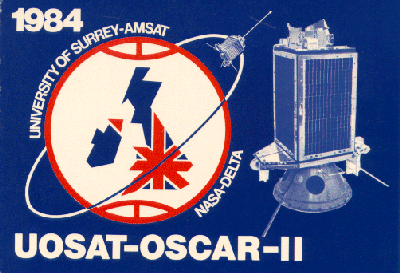UoSAT-OSCAR-11 has been in orbit since 1984 and remarkably its signal on 145.826 MHz FM (AFSK 1200 bps ASCII) is still being received.
UoSAT-2, also known as UoSAT-OSCAR-11 or UO-11, was the second satellite designed and built by a team of engineers at the University of Surrey in Guildford, Surrey, UK and was the successor to UoSAT-1 / UoSAT-OSCAR-9 (see Hobby Electronics August 1981). It was launched from the Western Test Range at Vandenberg Air Base, in Lompoc, California along with LANDSAT-5 on a Delta 3920 rocket on March 1, 1984.
UO-11 was the most rapidly designed OSCAR, going from inception to launch in only five months. It was also the first amateur satellite to carry a digital communications package into Earth orbit, and the first to be controlled by a CPU running software written in the high-level programming language “Forth”.
 UO-11 carries beacons in three amateur radio bands.
UO-11 carries beacons in three amateur radio bands.
The 145.826 MHz beacon transmits FM Audio Frequency Shift Keying (AFSK) 1200 bps ASCII data. It the early years it also transmitted a voice message from the digitalker experiment.
The 435.025 MHz beacon transmitted either 1200 bps FM AFSK or 4800 bps PSK data. This beacon was used to downlink information from the Digital Store and Readout (DSR) Experiment, which includes CCD Earth image data, results from the Particle Wave Experiment, and engineering data from the RCA COSMAC 1802 CPU.
The 2401.5 MHz beacon transmitted FM and PSK signals. Antenna polarization for all three beacon transmitters is left-hand circular (LHCP). Only the 145.826 MHz beacon is now operational.
Read Usenet messages from 1984 about UoSAT-B / UoSAT-2
Information compiled by Clive Wallis G3CWV
https://web.archive.org/web/20150413193503/http://g3cwv.co.uk/oscar11.htm
UO-11 page on the DK3WN satellite blog at http://www.dk3wn.info/p/?cat=47
SSTL Blog – Happy 30th Birthday to UoSAT-2
http://www.sstl.co.uk/Blog/March-2014/Happy-30th-Birthday-to-UoSAT-2-
OSCAR-9 and OSCAR-11 TV News Reports
https://amsat-uk.org/2011/10/30/oscar-9-and-oscar-11-tv-news-reports/
BBC Micro ASTRID UoSAT receiver and AMSAT-UK Software Library
https://amsat-uk.org/2011/12/11/bbc-micro-and-amsat-uk-software-library/
Information on UoSAT-1 (OSCAR-9) which was launched October 6, 1981
The UoSAT-1 Technical Handbook lists these contributors to the project:
Telecommand System and Flight Configuration – Dr. Martin Sweeting G3YJO, UOS/AMSAT-UK
Power Systems – Jerzy Slowikowski, UOS/AMSAT-UK
Telemetry – Dr. Lui Mansi, UOS/AMSAT-UK
Data Beacons – Bob Haining, UOS/AMSAT-UK
Antenna Systems – Tony Brown, UOS/AMSAT-UK
Navigation Magnetometer – Christine Sweeting G6APF, UOS/AMSAT-UK
Spacecraft Microcomputers – Chris Haynes, UOS/AMSAT-UK
HF Beacons – Colin Smithers G4CWH, UOS/AMSAT-UK
CCD Camera Imaging – Dr Paul Taylor, UOS/AMSAT-UK
30th Anniversary of UoSAT-1 (OSCAR-9) https://amsat-uk.org/2011/10/12/30th-anniversary-of-uosat-1-oscar-9/
UoSAT-1 – OSCAR-9 story in Daily Mail Newspaper Archive
https://amsat-uk.org/2013/06/28/uosat-in-daily-mail-archive/




You must be logged in to post a comment.